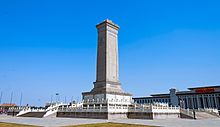人民英雄纪念碑 | |
 Monument from southwest, 2014 | |
 | |
| 39°54′11″N 116°23′30″E / 39.90306°N 116.39167°E | |
| Location | Tiananmen Square, Beijing, China |
|---|---|
| Designer | Liang Sicheng, Lin Huiyin |
| Type | Cenotaph |
| Material | Marble, granite |
| Height | 38 metres (125 ft) |
| Beginning date | August 1952 |
| Completion date | May 1958 |
| Dedicated to | Veterans of Chinese wars 1842–1949 |
The Monument to the People's Heroes (Chinese: 人民英雄纪念碑; pinyin: Rénmín Yīngxióng Jìniànbēi) is a ten-story obelisk that was erected as a national monument of China to the martyrs of revolutionary struggle during the 19th and 20th centuries. It is located in the southern part of Tiananmen Square in Beijing, in front of the Mausoleum of Mao Zedong. The obelisk monument was built in accordance with a resolution of the First Plenary Session of the Chinese People's Political Consultative Conference (CPPCC) adopted on November 30, 1949, with construction lasting from August 1952 to May 1958. The architect of the monument was Liang Sicheng, with some elements designed by his wife, Lin Huiyin. The civil engineer, Chen Zhide (陈志德) was also instrumental in realizing the final product.[1]
The monument is 37.94 meters high, sitting south to north, from bottom to top for the pedestal, giant pedestal, the pedestal body, the top of the monument, the pedestal inlaid with eight large reliefs and two small reliefs, all to the theme of the major events of modern Chinese history. The center stone of the stele is taken from Laoshan Mountain, Qingdao, with "Eternal glory to the people's heroes" handwritten by Chairman of the Chinese Communist Party Mao Zedong on the front, and the inscription written by Mao and Premier Zhou Enlai on the back. Since its construction, the monument has been repaired many times, and in 1961, the Monument to the People's Heroes was listed as a Major cultural heritage sites under national-level protection.
- ^ "The Monument to the People's Heroes". news.sohu.com (in Chinese). 2009-08-07. Retrieved 2021-07-28.